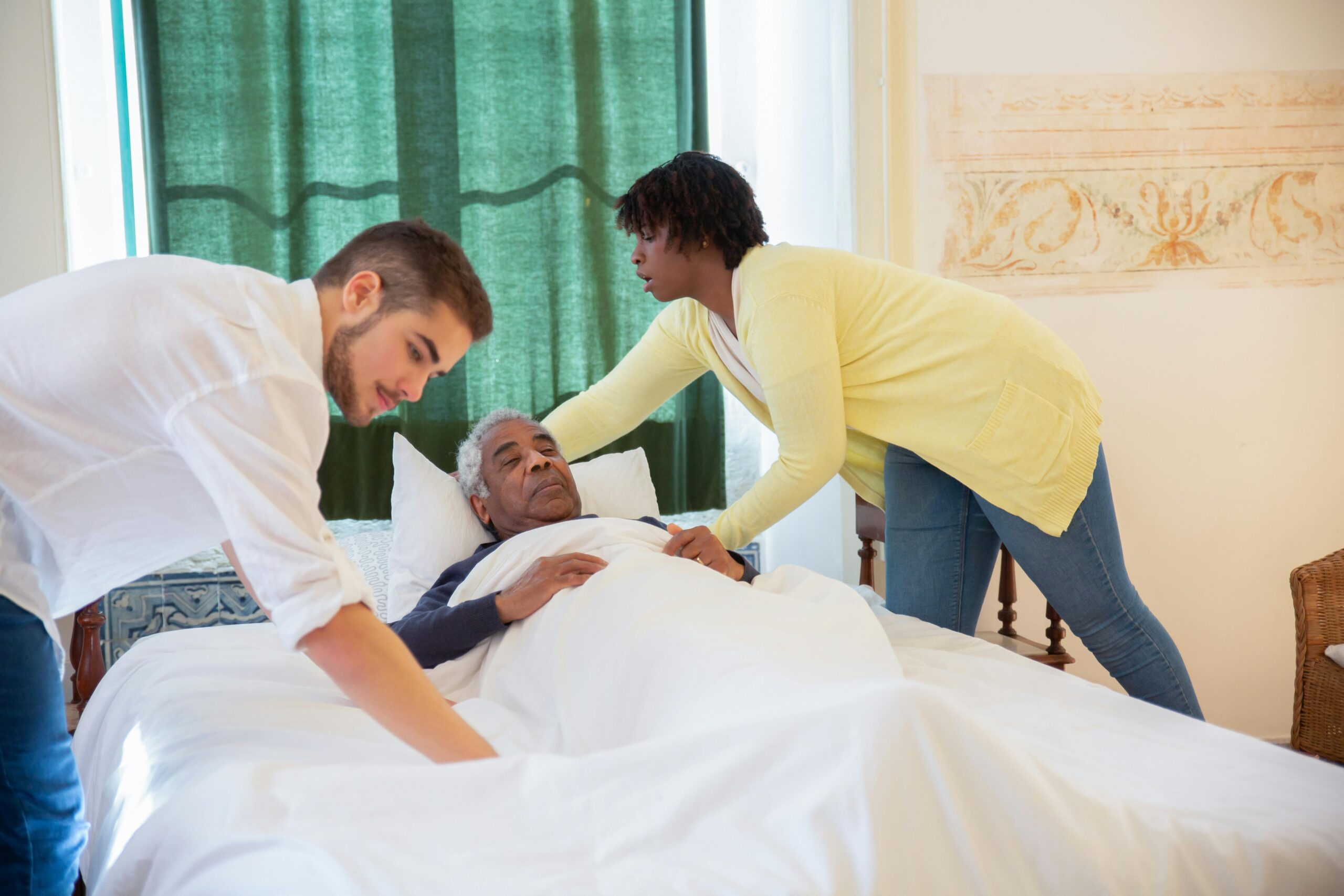If you’re searching for a bed alarm for elderly individuals, the key is to find one that balances prompt alerts with unobtrusive monitoring. This article provides a no-nonsense look at the technology behind bed alarms, their benefits, and hands-on advice for selecting the right model to safeguard your loved one at night. We’ll also highlight top picks and factors to weigh before purchasing a bed alarm for elderly
Table of contents

Understanding Bed Alarms for the Elderly
A bed alarm, also known as a bed exit alarm, is a system engineered to sound an alarm when an elderly individual tries to leave their bed. These devices, along with chair alarms, are integral in preventing falls, a significant concern among the elderly. They are widely utilized in various care settings, from homes to nursing facilities, proving to be essential tools for caregivers.
But how exactly does a bed alarm work? The operation of a bed alarm for elderly consists of three simple steps
- A sensor that is placed under the mattress or on the bed frame.
- When the sensor detects movement, such as the patient trying to leave the bed, it triggers an alarm
- This gives the caregiver a chance to assist the patient, thereby reducing the risk of falls.
Benefits of Bed Alarms for Elderly Models
Bed alarms are advantageous in elder care for several reasons. A significant one is their capability to notify caregivers promptly when an elder attempts to leave their bed. This swift alert enables caregivers to intervene immediately, potentially averting a fall.
Additionally, the sound of the alarm could remind the elderly to ask for help rather than attempting to leave the bed on their own. Certain models even feature alarm sounds with a delay option to mitigate false alarms triggered by insignificant, non-emergency movements.
For those caring for dementia patients, systems like the Secure Caregiver Alert System offer an added layer of safety with enhanced monitoring capabilities.
Types of Bed Alarm Sensors and their Advantages and Drawbacks
Just as people are unique, so too are the needs of each elderly individual. That’s why bed alarms come with various types of sensors to cater to different needs. Some common types of sensors include:
Pressure sensor pads
These trigger an alarm when a patient gets up from the bed. These are often hidden under bed sheets and provide reliable alerts.
Motion sensor alarms
These use motion detection to alert when a patient gets out of bed. Floor sensor pads may miss certain unsafe behaviors if the patient doesn’t touch the floor,
String alarms
These connect to a patient’s clothing and sound an alarm when detached. This option offers a simple and cost-effective solution, but they carry a risk of strangulation and may be tampered with by some patients.
Hence, when selecting a bed alarm for the elderly, it’s vital to take into account the specific needs of the patient.
Factors to Consider When Choosing a Bed Alarm for the Elderly
Selecting the right bed alarm isn’t as simple as picking the first one you see on the shelf. There are several factors to consider to ensure you choose a bed alarm that best fits your needs and those of your elderly loved one. It’s vital to take into account the specific needs of the patient.
There are a lot of doubts that can be carried when buying a bed alarm for elderly, such as the noise level o if should you choose a wired instead of a wireless bed alarm, ease of installation and last but not least the cost that a bed alarm for elderly has..
Noise Levels and Alarm Styles
The noise level of bed alarms for elderly is a significant factor to consider. They should emit a sound loud enough for caregivers to hear, but not so loud that it disrupts or annoys others. Most bed alarms emit a repeated chime tone and feature adjustable volume controls to suit different environments and caregiver needs.
There are also silent bed alarms that send a signal to a caregiver’s pager or smartphone instead of emitting a loud noise. These can prevent patient confusion or agitation, especially during the night.
Wired vs Wireless Bed Alarms
Should you choose a wired or wireless bed alarm? This is another important decision when selecting a bed alarm. Wireless bed alarms offer portability and flexibility, making them convenient for use in both home and care center settings. However, they do come with potential drawbacks, such as signal interference from other devices and varying battery life, which might compromise their reliability.
On the other hand, wired bed alarms are known for their reliability and lower costs compared to their wireless counterparts. That being said, they do have their own set of disadvantages, such as installation complexities, potential tripping hazards due to wires, and potential discomfort for the user in bed positioning.
Budget and Pricing Options
The budget is a primary factor to consider when selecting a bed alarm for your elderly loved one. Bed alarms are available at a range of prices, from approximately $30 to over $500, catering to different needs and budgets. However, it’s not just the initial purchase price that matters. Ongoing costs for maintenance and updates are also crucial to consider when investing in a bed alarm system.
For instance, monitoring devices, connection cables, and sensor pads all contribute to the overall investment, with costs around $350 for monitoring boxes and cables and approximately $23 for each disposable sensor pad. While the pricing of advanced bed alarm technologies may pose a barrier for some, it’s important to evaluate the effectiveness of bed alarms relative to their cost, as expectations regarding their role in fall prevention programs can vary.
Additional Safety Measures to Complement Bed Alarms
Although bed alarms are critical in preventing falls among the elderly, they shouldn’t be the only safety measure. Combining them with other safety precautions can improve night-time safety for the elderly.
Grab bars
The use of suction cup grab bars and customizable grab bars that offer temporary and portable solutions for fall prevention. However, for these supplementary safety measures to be dependable, regular maintenance checks are required to ensure they are securely fastened and devoid of any damage or corrosion.
Non-Slip Mats and Flooring
Another effective measure is the use of non-slip mats and flooring. These help prevent slipping, which is especially important for seniors who may have reduced balance or mobility. By placing non-slip mats beside beds, you can provide additional safety for the elderly when getting in and out of bed.
Moreover, installing non-slip flooring solutions throughout the bedroom and adjoining areas ensures a safe walking surface for the elderly at night. This can offer an extra layer of protection, giving you peace of mind that your loved ones are safe
Low Beds and Fall Risks
One such additional safety measure is the use of low beds. By reducing the distance between the bed and the floor, low beds significantly lower the fall risk for the elderly. A low bed that enables users to place their feet flat on the floor while sitting on the edge can offer better leverage and stability when getting in and out of bed.
There are various options to consider, from standard low beds with a minimum height of about 9 ½ inches from the ground, to ultra-low beds and floor beds that minimize the risk of serious injury from a bed fall even further,.
Summary
In conclusion, bed alarms play a vital role in enhancing night-time safety for the elderly. By providing early alerts to caregivers, they reduce the risk of falls and ensure timely care for our loved ones. While there are many types of bed alarms available, it’s important to choose one that best fits your needs and those of your elderly loved one. Consider factors such as noise levels, wired or wireless options, and cost.
And remember, bed alarms should be used in conjunction with other safety measures, such as low beds and non-slip mats, to further enhance elderly safety. By investing in the right bed alarm system, you can ensure the well-being and safety of your loved ones, providing them with the care they deserve.
FAQ
Medicare does not cover bed alarms or medical alert systems, but Medicare Advantage and some long-term care insurance plans may offer coverage for these devices. It’s important to check with your specific plan for details.
Yes, there are bed alarms available that can send alerts to a caregiver’s phone or sound an alert when someone gets out of bed, providing an extra layer of safety and monitoring.
The problems with bed alarms include hindering patient sleep and limiting mobility, which can lead to blood clots and muscle atrophy if prolonged. Be cautious of these potential drawbacks when using bed alarms.
Bed alarms are effective in helping to prevent falls for many at-risk patients, especially those who are slow-moving or frail.
A bed alarm is a device that alerts caregivers when an elderly person tries to get out of bed, helping to prevent falls.


